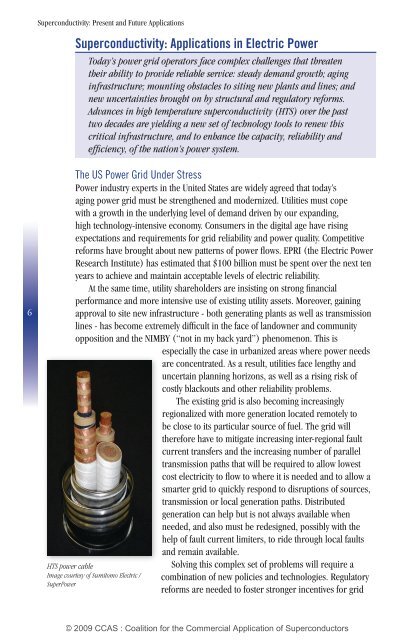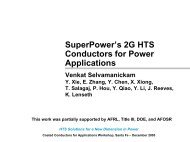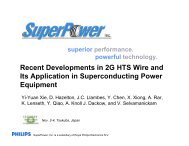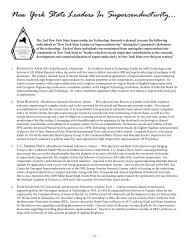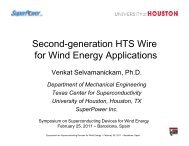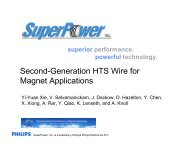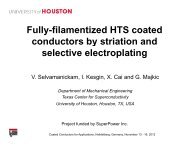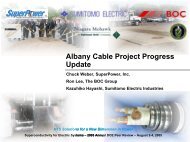superconductivity - CCAS - Coalition for the Commercial Application ...
superconductivity - CCAS - Coalition for the Commercial Application ...
superconductivity - CCAS - Coalition for the Commercial Application ...
Create successful ePaper yourself
Turn your PDF publications into a flip-book with our unique Google optimized e-Paper software.
Superconductivity: Present and Future <strong>Application</strong>s<br />
Superconductivity: <strong>Application</strong>s in Electric Power<br />
Today’s power grid operators face complex challenges that threaten<br />
<strong>the</strong>ir ability to provide reliable service: steady demand growth; aging<br />
infrastructure; mounting obstacles to siting new plants and lines; and<br />
new uncertainties brought on by structural and regulatory re<strong>for</strong>ms.<br />
Advances in high temperature <strong>superconductivity</strong> (HTS) over <strong>the</strong> past<br />
two decades are yielding a new set of technology tools to renew this<br />
critical infrastructure, and to enhance <strong>the</strong> capacity, reliability and<br />
efficiency, of <strong>the</strong> nation’s power system.<br />
6<br />
The US Power Grid Under Stress<br />
Power industry experts in <strong>the</strong> United States are widely agreed that today’s<br />
aging power grid must be streng<strong>the</strong>ned and modernized. Utilities must cope<br />
with a growth in <strong>the</strong> underlying level of demand driven by our expanding,<br />
high technology-intensive economy. Consumers in <strong>the</strong> digital age have rising<br />
expectations and requirements <strong>for</strong> grid reliability and power quality. Competitive<br />
re<strong>for</strong>ms have brought about new patterns of power flows. EPRI (<strong>the</strong> Electric Power<br />
Research Institute) has estimated that $100 billion must be spent over <strong>the</strong> next ten<br />
years to achieve and maintain acceptable levels of electric reliability.<br />
At <strong>the</strong> same time, utility shareholders are insisting on strong financial<br />
per<strong>for</strong>mance and more intensive use of existing utility assets. Moreover, gaining<br />
approval to site new infrastructure - both generating plants as well as transmission<br />
lines - has become extremely difficult in <strong>the</strong> face of landowner and community<br />
opposition and <strong>the</strong> NIMBY (“not in my back yard”) phenomenon. This is<br />
especially <strong>the</strong> case in urbanized areas where power needs<br />
are concentrated. As a result, utilities face lengthy and<br />
uncertain planning horizons, as well as a rising risk of<br />
costly blackouts and o<strong>the</strong>r reliability problems.<br />
The existing grid is also becoming increasingly<br />
regionalized with more generation located remotely to<br />
be close to its particular source of fuel. The grid will<br />
<strong>the</strong>re<strong>for</strong>e have to mitigate increasing inter-regional fault<br />
current transfers and <strong>the</strong> increasing number of parallel<br />
transmission paths that will be required to allow lowest<br />
cost electricity to flow to where it is needed and to allow a<br />
smarter grid to quickly respond to disruptions of sources,<br />
transmission or local generation paths. Distributed<br />
generation can help but is not always available when<br />
needed, and also must be redesigned, possibly with <strong>the</strong><br />
help of fault current limiters, to ride through local faults<br />
and remain available.<br />
HTS power cable<br />
Image courtesy of Sumitomo Electric /<br />
SuperPower<br />
Solving this complex set of problems will require a<br />
combination of new policies and technologies. Regulatory<br />
re<strong>for</strong>ms are needed to foster stronger incentives <strong>for</strong> grid<br />
© 2009 <strong>CCAS</strong> : <strong>Coalition</strong> <strong>for</strong> <strong>the</strong> <strong>Commercial</strong> <strong>Application</strong> of Superconductors


